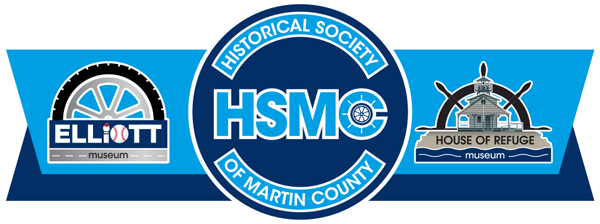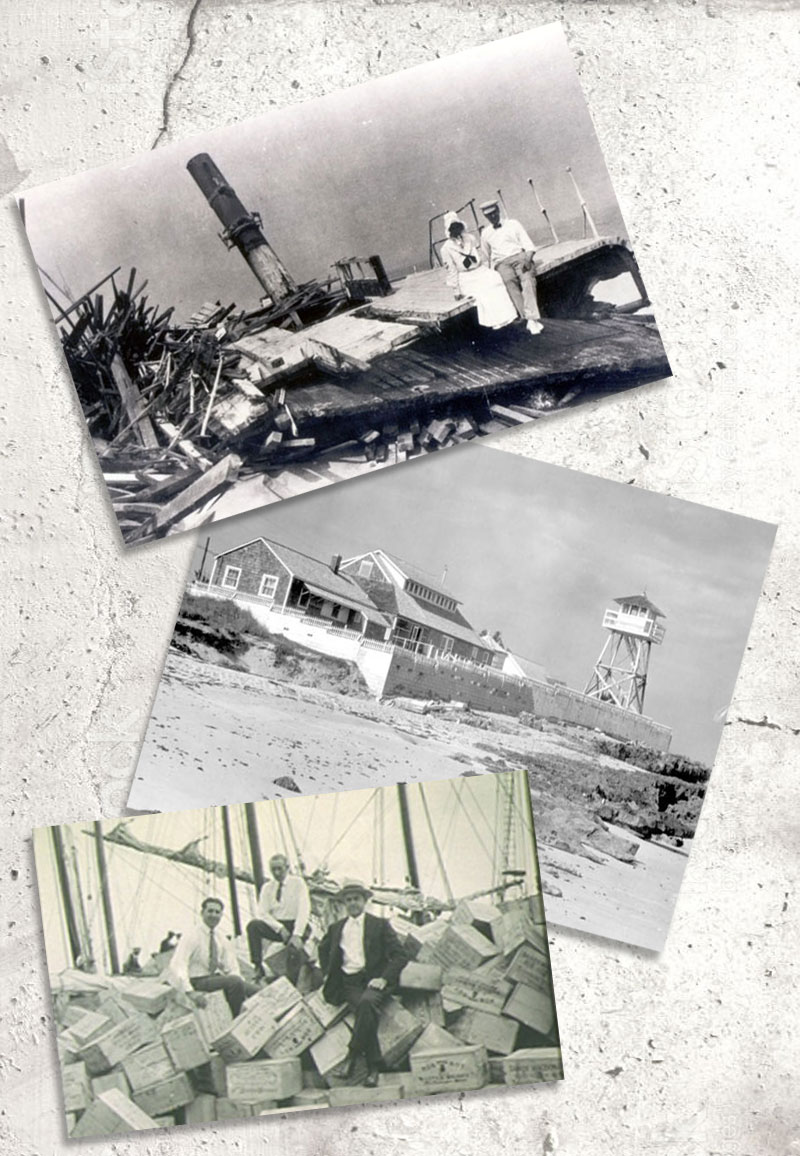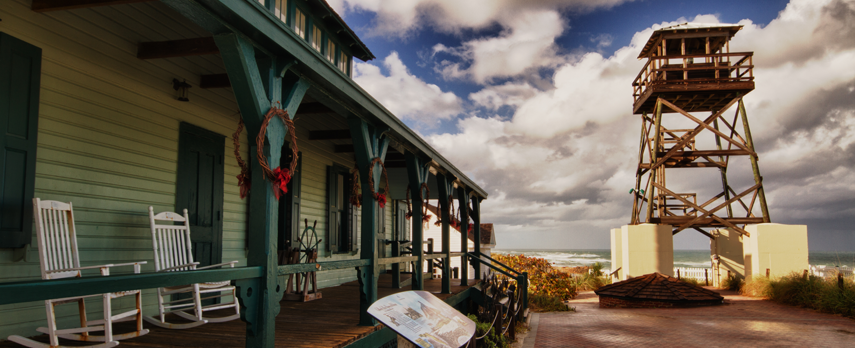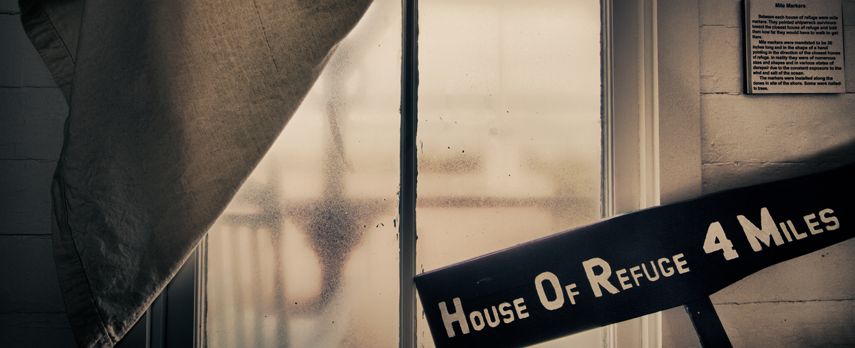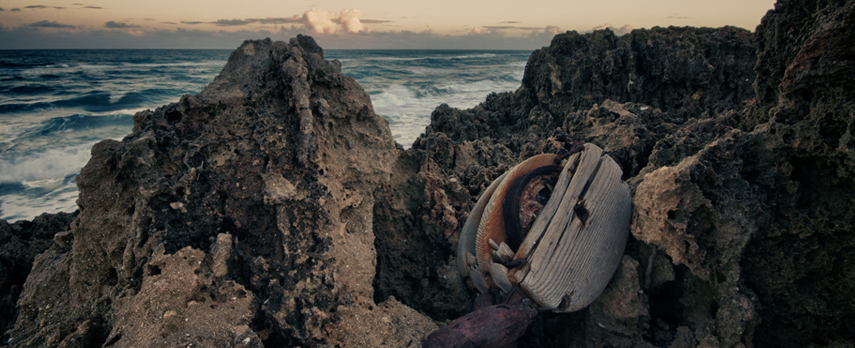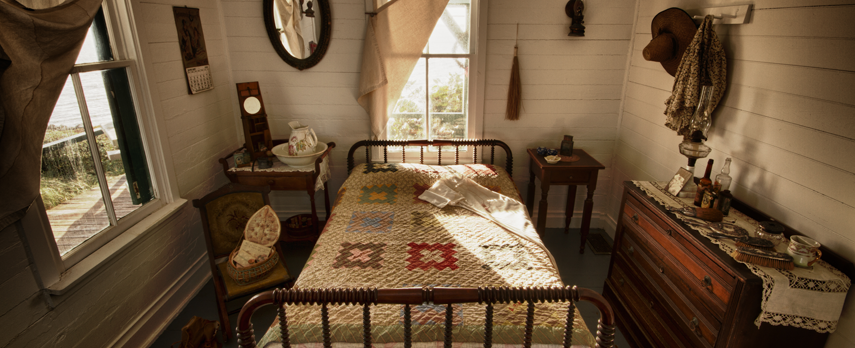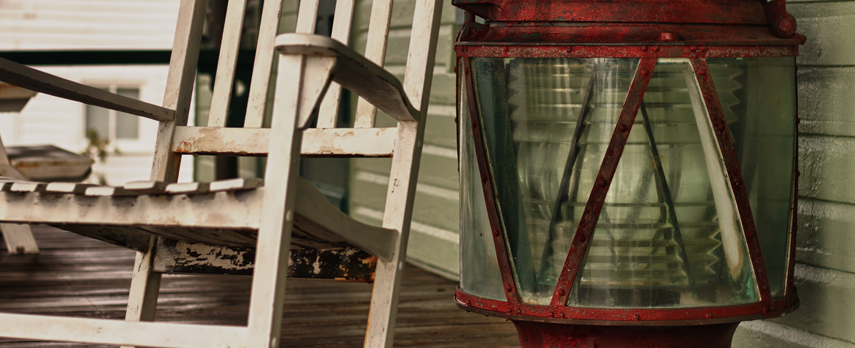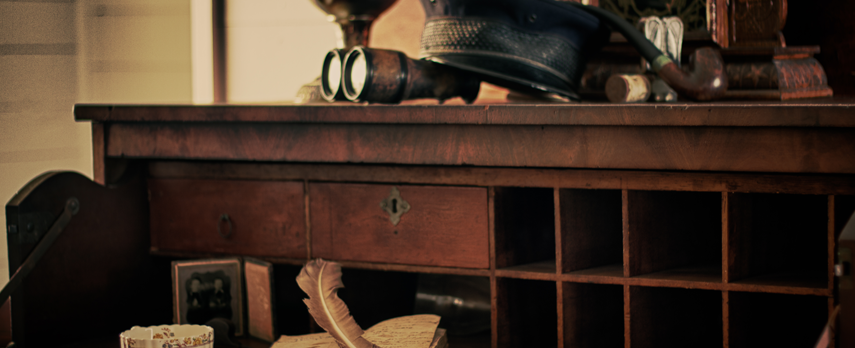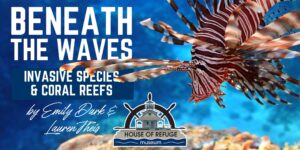HOUSE OF REFUGE
INTERACT • DISCOVER • LEARN
Step back in time to the turn of the century with a visit to the House of Refuge Museum at Gilbert’s Bar. Built as one of ten along the east coast of Florida, it is the oldest structure in Martin County and is the only remaining House of Refuge.
Want to visit the wreck of Georges Valentine? Only 100 yards from shore, you can walk from the House of Refuge and snorkel or dive the wreck.
Looking for the ideal Beach Wedding or an Ocean side Event? We can make it happen! Select your many options below and DISCOVER WHAT POSSIBILITIES AWAIT YOU!
DISCOVER WHAT POSSIBILITIES AWAIT YOU!
ABOUT HOUSE OF REFUGE
The Oldest Structure in Martin County
The Houses of Refuge were designated as havens for shipwrecked sailors and travelers along the sparsely populated Atlantic coastline of Florida. Run by the United States Lifesaving Service, the Houses played a critical role in a time when sailing ships dominated the world commerce.
The historic structure has weathered many storms and provided needed shelter for shipwreck survivors, including those of the Georges Valentine, an Italian brigantine whose wreckage remains just 100 yards off the rocky shoreline, providing an ideal dive site.
The history of the House of Refuge
dates to 1876, when the U.S. Life-Saving Service, under the direction of Sumner Kimball, constructed ten “houses of refuge,” or life-saving stations, along Florida’s Atlantic Coast.
These houses were staffed by “keepers,” who, with their families, led solitary lives in order to find, rescue, and minister to those who fell victim to Florida’s treacherous reefs and shoals. Prior to construction of these houses, many shipwreck victims made it to the isolated shore and then perished of starvation and thirst. As part of their duties, the keeper and his family walked along the shores as far as possible in search of shipwreck victims.
In 1915 the U.S. Life-Saving Service merged with the U.S. Revenue Cutter Service to form the U.S. Coast Guard, and then the House of Refuge became U.S. Coast Guard Station #207. The keeper at the time, Axel Johansen, and his wife, Kate, remained on duty, but Alex’s title was changed from Keeper to Surfman #1. Four other men were stationed at the house, and during World War I this crew of five was augmented by the Home Guard, composed of area youths.
In 1942, when German U-Boats torpedoed freighters along the Treasure Coast, a lookout tower and additional buildings were constructed on the property. In 1945 the U.S. government decommissioned House of Refuge operations, and the house sat empty until 1953, when Martin County purchased it and its 16-acre grounds for $168.
In 1955 the Martin County Historical Society was formed to protect the house and present it as a museum. Almost immediately, in addition to serving as a museum, the House of Refuge became a refuge for sea turtles, with this program being under the direction of Ross Witham (1917–2004), Marine Turtle Coordinator for the Florida Department of Natural Resources from 1963 to 1987. Now sea turtles, rather than shipwreck victims, depend on the life-saving measures of the House of Refuge.
Today the House of Refuge is itself a survivor; it is the only one of the original ten houses of refuge to remain on the Florida Coast. Today it tells the story of the region’s significant maritime heritage and the Floridians who endured hardships for the sake of humanitarian service.
HOUSE OF REFUGE GALLERY
HOUSE OF REFUGE VIDEOS
GEORGES VALENTINE DIVE SITE
DIVE • SNORKEL • DISCOVER
The wreck of Georges Valentine is a pleasure to dive or snorkel.
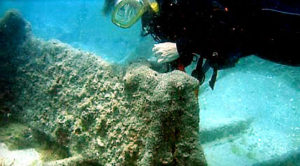
Georges Valentine is a pleasure to dive or snorkel because she rests in shallow water, only 100 yards offshore. Visitors can park at the House of Refuge and walk to the entry point, a rocky outcropping l00 yards south.
Learn more about the Georges Valentine shipwreck during your tour of the House of Refuge Museum before you dive. Call us for more information on Guided Tours.
LOCATION
The wreck of Georges Valentine is situated approximately l00 yards south of the south wall of Gilbert’s Bar House of Refuge and 100 yards directly offshore in Stuart, Florida. Coordinates for the wreckage closest to the beach (including the boiler, a 57′ section of deck with 8′ of broken mast, and a 12′ by 12′ section of tile floor), are 27° 11.93 ‘ N and 80° 09.88′ W. A 65′ section of iron hull, 16′ in height, is approximately 80 yards due east of the boiler section at 21° 11.93′ N and 80° 09.83′ W. Also in this area are two broken sections of steel mast, one 10′ in length and the other, on the north side of the hull, 19′ in length.
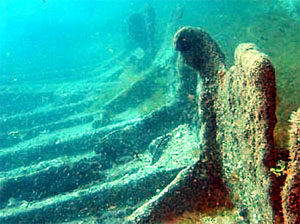
Extending from the east edge of the hull is a 100′ section of the keel and frames. Directly south of the hull is a large debris field that extends about 80′ to the south and 60′ east and west. Approximately 130′ due south of the largest hull section are hull plates about 12′ wide by 20′ in length at coordinates 27° 11.91′ N and 80° 09.83′ W. What appears to be a crane for loading cargo is located approximately 40′ south of the hull plates at coordinates 27° 11.90′ N and 80° 09.83′ W.
Approximately 495′ south of the House of Refuge is a 19′ section of a steel mast partially buried in the sand on shore. Directly due east of this artifact in the surf zone is a segment of iron framework about 60′ long by 24′ wide, along with another section of a broken steel mast, at coordinates 27° 11.89′ N and 80° 09.87’ W.
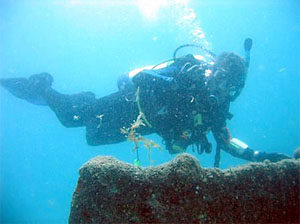
PHYSICAL DESCRIPTION OF THE DIVE SITE
Georges Valentine is partially buried in the sand and is broken into five prominent sections. Sand migrates to and from the site depending on seasonal weather and storms. For example, in August 2003 the sand had migrated away, providing a very clear view of the tile deck and the ability to swim under sections of super structure; by August 2004 the sand migrated closer to the wreckage and obscured many features including the debris field. Depth of water around the hull in August 2003 was approximately 32 feet; in August 2004 depth was only 22 feet.
The wreckage lies in positions consistent with reports written by Captain Rea in 1904. An existing photograph (circa 1905) in the Historical Society of Martin County archives shows a large section of upper deck with a mast on the rocks, and the House of Refuge in the background. This wreckage includes the mast and framework 495′ south of the House of Refuge that can be seen today.
BIOLOGICAL DESCRIPTION OF DIVE SITE
Marine life abounds on the wreck of Georges Valentine, including snook, sheepshead, margate, angelfish, kingfish, shiners, shark, moray eels, stingrays, lobster, stone crab, hermit crab, puffer, trigger, parrotfish, wrasse, snapper, and various species of soft corals. Because of the shallow water and migrating sand, the sea life changes from season to season as dramatically as the wreck itself. If not for the unfortunate circumstances of the wreck, there would not be a safe haven for the variety of sea life found there today.
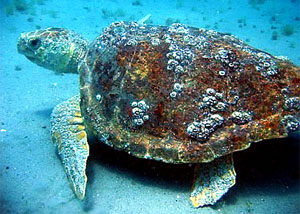
Sea life abounds and is dependent upon the season. Migration of the sand is dramatic; as much as six feet of sand can move in a single year. This change in conditions is a common occurrence and allows divers to enjoy a new adventure with every visit to the shipwreck.
The shoal where Georges Valentine rests is named after the pirate Don Pedro Gilbert who, according to local legend, hung lanterns on the shore in the area where the House of Refuge stands to lure unsuspecting ships onto the rocks. The rock shoreline is the foundation for the Gilbert’s Shoal (Bar) House of Refuge, and is one of the reasons the building is still standing today.
Georges Valentine Underwater Archaeological Preserve Hutchinson Island, Stuart, Florida, by the Florida Department of State Division of Historical Resources Bureau of Archaeological Research
HOUSE OF REFUGE LECTURES & EVENTS
FINAL TOUR! The Wreck of the 1715 Treasure Fleet
301 Southeast MacArthur Boulevard, Stuart, Florida 34996
Beneath the Waves
301 Southeast MacArthur Boulevard, Stuart, Florida 34996
Beyond The Veil
825 NE Ocean Boulevard, Stuart, FL 34996
Beyond The Veil
825 NE Ocean Boulevard, Stuart, FL 34996
What’s going on at the House?
DISCOVER monthly events and news for 2025
Monthly newsletter posts from Catherine Larson, Keeper of the House.
HOUSE OF REFUGE UPDATES:
EXCITING EXHIBITS, ENGAGING LECTURES & UNIQUE TREASURES!
The Coastal Colors Paint Out at the House of Refuge Show is going strong on the second floor of the Elliott Museum and will be on display until May 16th! This incredible collection showcases the work of talented local plein air artists who have captured the beauty, history, and maritime legacy of our treasured landmark. Be sure to visit and experience these stunning pieces before the show closes. All artworks are for purchase!
We are also thrilled to present a lineup of fascinating lectures at the House of Refuge:
The Spanish Fleet Shipwreck of 1715 – April 9th at 2 p.m.
This will be the final opportunity to catch this overwhelmingly popular lecture! Discover the gripping story of the ill-fated Spanish treasure fleet, lost to a hurricane just off our shores, and the modern-day search for its legendary riches.
Florida’s Coral Reefs, Lionfish, and Conservation Efforts – April 14th at 2 p.m.
Dive into the world of Florida’s coral reefs, their vital role in marine biodiversity, and the threats they face from environmental changes and invasive species. Learn how the lionfish, an invasive species, is disrupting the balance of our underwater ecosystems and discover the innovative conservation efforts being used to protect our reefs.
Seating is limited, so reservations are required.
Take advantage of our Shuttle Service from the Elliott Museum!
Shuttles depart at 1:00, 1:20, and 1:40 p.m. with a reservation.
Call 772-225-1875 to reserve your spot today!
Discover Nautical Treasures at The Boathouse!
Before or after your visit, stop by The Boathouse, our charming gift shop, where you’ll find a treasure trove of books reflecting our rich maritime history and seafaring legends. Explore our stunning artisan decoupage shells, each handcrafted with intricate designs inspired by the ocean. Take home a piece of history with our House of Refuge clothing, unique keepsakes, and so much more. Whether you’re looking for the perfect gift or a special reminder of your visit, The Boathouse is filled with coastal charm and one-of-a-kind finds!
House of Refuge Museum
301 SE MacArthur Blvd.
Stuart, FL 34996
772-225-1875
www.hsmc-fl.com
EXCITING UPDATES & WAYS TO GET INVOLVED!
COASTAL COLORS EXHIBIT NOW ON DISPLAY AT THE ELLIOTT MUSEUM!
The Coastal Colors exhibit opened to a fantastic reception, showcasing an incredible array of artwork created during the inaugural Coastal Colors Plein Air Paint Out at the House of Refuge. The event was a tremendous success, bringing together talented plein air artists from Martin, Palm Beach, and St. Lucie counties, as well as art lovers and history enthusiasts, to celebrate the beauty and legacy of this historic landmark.
There’s still plenty of time to experience the exhibit! Coastal Colors will remain on display at the Elliott Museum through May 15, 2025. This is also a fantastic opportunity to take home a piece of history and art—the artwork is available for purchase but must remain on display throughout the show. Art makes a thoughtful and unique gift for someone special!
While at the museum, please stop in The Boathouse Gift Shop, where you’ll find a treasure trove of great gifts, including an extensive collection of history books reflecting our local maritime heritage.
And don’t forget to sign up for one of our engaging lectures! We offer an intimate boutique setting where knowledgeable speakers share fascinating insights into history and local lore.
Upcoming topics include:
- The Spanish Fleet of 1715 Shipwrecks
- Rum Runners of the Treasure Coast
- and more!
Explore, learn, and celebrate the rich history of the Treasure Coast with us!
Adopt an Artifact – Be a Part of History!
Our Adopt an Artifact program is going strong! This is your chance to connect with history in a meaningful way by adopting your favorite piece of the past. Each adoption directly supports the House of Refuge, helping us preserve and share the incredible stories of this historic site.
Visit our website to explore the available artifacts and become a steward of history today! Your support ensures that our museum continues its journey in preserving and sharing the legacy of the House of Refuge for generations to come.
Dedicate a House of Refuge Rocking Chair – A Beautiful Tribute
Are you looking for a meaningful way to honor someone special? Dedicate a House of Refuge Rocking Chair in their name! These charming rocking chairs grace the porches of the House of Refuge, offering a place to sit, reflect, and take in the breathtaking ocean views.
A rocking chair dedication is a unique and heartfelt tribute—perfect for honoring a loved one, celebrating a milestone, or creating a lasting memory at this historic landmark. Each dedication includes a personalized plaque, ensuring your honoree’s name becomes part of the House of Refuge’s enduring story.
This special gesture not only commemorates someone dear to you but also supports the preservation of the House of Refuge, helping us continue our mission of sharing its history.
To learn more about dedicating a rocking chair, visit our website or reach out to us today!
Celebrating Our Incredible Docent Volunteers!
Our docent volunteers are the heart and soul of the House of Refuge! Their dedication, knowledge, and passion bring history to life for our visitors every day. Whether leading tours, sharing maritime stories, assisting with exhibits, or helping behind the scenes, their commitment to preserving and sharing the House of Refuge’s legacy is genuinely inspiring.
We are grateful to each of our volunteers who have dedicated their time to keeping this historic treasure alive. Their efforts ensure guests learn about our rich past and connect with the stories that make the House of Refuge special.
So next time you visit, thank a docent for their hard work! Interested in joining this incredible team? We’re always looking for enthusiastic volunteers to share in our mission. Reach out today and become part of the House of Refuge family!
Stay Connected & Get Involved!
Follow us on social media for the latest updates, events, and ways to support the House of Refuge. Thank you for supporting our mission to preserve history, inspire learning, and celebrate the Treasure Coast’s rich maritime heritage!
House of Refuge Museum
301 SE MacArthur Blvd.
Stuart, FL 34996
772-225-1875
www.hsmc-fl.com
COASTAL COLORS PAINT OUT:
 A STUNNING SUCCESS!
A STUNNING SUCCESS!
With our deepest gratitude, we thank all the talented plein air artists who participated in this inaugural event. The Coastal Colors Paint Out at the House of Refuge was a vibrant celebration of art, history, and community.
Over 40 gifted artists from Martin, Palm Beach, and St. Lucie counties came together to capture the charm and rich history of our beloved landmark, producing breathtaking works of art. The event was such a success, it even made the cover of The Stuart News!
Now, the magic continues with the Inaugural Coastal Colors Exhibit at The Elliott Museum, running from February 11 through May 16, 2025.
This exhibit is more than just a showcase; it’s a heartfelt way to honor the House of Refuge as we look toward celebrating its 150th Anniversary in 2026. After all these years, she still stands strong—a beacon of endurance and significance. Featuring her as the muse for these incredible pieces is a fitting tribute to her enduring legacy.
Celebrate the Legacy of Someone You Cherish: Adopt An Artifact
Looking for a meaningful way to honor a loved one? Adopt an artifact in their name at the House of Refuge. Your dedication celebrates someone special and supports the preservation of historical treasures that connect us to Florida’s maritime heritage. By adopting an artifact, you contribute to the care and conservation of these timeless pieces, ensuring their stories are passed down to future generations.
Join us in safeguarding the past and celebrating the people who make it personal. Learn more about adopting an artifact and becoming part of this enduring legacy.
